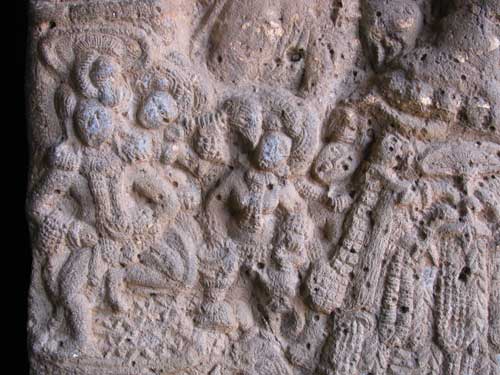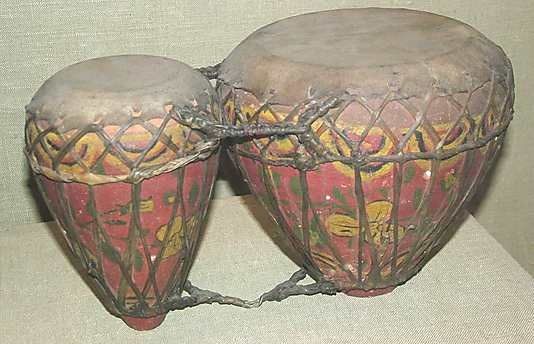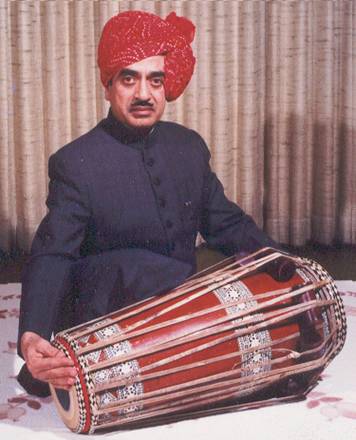A Brief History of the Tabla
Overview
The various classical music traditions of India have a long, complex history, with roots going back to vedic times. The classical tabla tradition shares some of these roots, but is a relatively recent tradition, most likely beginning sometime in the 1700s.
Despite this recent history, the origins and evolution of the tabla are not well understood.
What we do know is that, at some point, the tabla, or some earlier version of the tabla, became the main accompaniment instrument for the vocal style known as khyal. Khyal was the most important music genre to emerge during the Mughal period, when Persian music influences blended with local Indian traditions.
Khyal is also the foundation of the North Indian classical music known as Hindustani or Shastriya Sangeet. This tradition eventually became the most popular form of classical Indian music, and remains so today, both in India and abroad.
The tabla’s connection with khyal helped to raise its status and popularity. And because of the tabla’s unparalleled flexibility, players were able to adapt it to a wide variety of drumming styles and music genres. As a result, the tabla eventually became the most popular drum of North India.
With this newfound importance, the tabla gharanas ("lineages" or "schools") began to emerge in the 1700s, eventually producing six major gharanas. These gharanas have together created the massive tabla repertoire that we have today.
Although the gharana tradition of the past is now mostly finished, modern players still have their roots in at least one of the major gharanas.
Origins of the Tabla Drums
The drums we now call the tabla most likely appeared somewhere between the late 1600s and the late 1700s. The small amount of historical evidence suggests that the tabla evolved in South Asia from a variety of possible ancestors and influences, including drums introduced by Muslim invaders such as the naqqara, as well as local drums such as the dholak, dhukkar or duggi, and the pakhawaj drum.

Dukkar or duggi drums, still common in shehnai accompaniment and Indian wedding ceremonies in Uttar Pradesh and the Punjab
However, there is still disagreement about the tabla’s origins, and just how old it is. The most common disagreement concerns whether or not the tabla originated in pre-Islamic India.
Some believe that ancient stone carvings, which show what appear to be upright hand drums, are proof that the tabla is an ancient Indian instrument. The Wikipedia entry on the tabla (at the time of this writing) states:
“…iconography carvings found in Bhaje caves providing solid proof that the tabla was used in ancient India.”
These arguments have been made before, but few scholars accept this as evidence (Gottlieb, Stewart, Wegner, and others address these arguments in their work).
The Bhaje carvings and other ancient depictions are not proof of an actual pair of tablas with its resonating syahi patch attached to the skins. They only show that there were other ancient drums which appeared to be played upright in pairs.

Bhaje stone carving, from around 200 BCE (courtesy Wikipedia)
Furthermore, numerous scholars have noted that, before the 19th century, there are no descriptions of any tabla-like drums in the various documents which describe many other musical instruments of their time. The first published description of a tabla-like instrument came in 1810, when F. Baltazard Solvyns described a "thobla", which strongly resembled the modern day tabla.
Unfortunately, we will probably never know exactly how the tabla drums came to be. But among scholars, there is a consensus that the modern Indian tabla evolved in the Indian sub-continent, though it probably did not take its current form until some time in the 1700s.
Popular Origin Stories
Aside from these historical arguments, many musicians have their own stories about the origin of the tabla. Students continue to learn these stories and so they should be mentioned here. Two of the most common are given below.
The Tabla Evolved from Muslim War Drums
One such story is that the tabla evolved from drums which were brought to the subcontinent by Muslim invaders. This could explain the name tabla which sounds very much like the Arabic word tabl, a generic term meaning “drum”.
The term tabl was used to refer to a number of possible tabla predecessors such as the Middle Eastern naqqara. The naqqara is a pair of cylindrical drums played upright with sticks, and was originally used in battles to frighten the enemy. Gottlieb notes that the late Keramatullah Khan (former head of the Farrukhabad gharana) believed that the tabla evolved from these drums (Vol. 1, p. 1).

Persian naqarra from late 19th century (courtesy Wikipedia)
The Tabla Evolved from the pakhawaj cut in half
Another common story is that the tabla was created by Amir Khusru (18th century) who cut a pakhawaj in half. This was the story that I first heard in Benares.

Raja Chhatrapati Singh playing Pakhawaj (courtesy dhrupad.org)
Because the construction of the pakhawaj skins are very similar to the tabla’s, this is a logical story (the smaller skin of the pakhawaj is virtually identical to that of the tabla). However, there is no historical evidence to support this story either, though it seems clear that the tabla adopted some of the pakhawaj’s features.
History of the Tabla Repertoire
The history of the classical tabla repertoire is essentially the history of the major gharanas (lineages) and of their most influential players.
Despite how relatively recent this history is, we understand little about exactly what was played, or how it was played, before the 20th century. Because so little material was written down, and because so many compositions and styles have moved back and forth between different gharanas, the history is vague.
What we do have is kind of general stylistic history of the major centers of development, most importantly the first two gharanas of Dilli and Luckow. Both were strongly influenced by their local drumming traditions.
Then came developments in the descendants of these two gharana: Ajrara was closely based on Dilli, while Farrukhabad and Benares were more closely based on Lucknow. The Punjab gharana developed more independently, but was also influenced by its own regional drumming traditions, including the pakhawaj.
Out of these stylistic centers, particular compositional forms emerged, and/or new approaches to older forms. Here again, the contributions of Dilli and Lucknow were most significant, but eventually all the major gharanas would make significant contributions to classical tabla.
Most modern tabla lineages now have similar repertoires which include compositions, or similar compositions, from all the gharanas. However, all gharanas also have unique material, and may still have significant differences in both style and technique.
This history is discussed in more detail in the sections on The Six Major Gharanas, Tabla Baj, and in some of the descriptions of compositional forms.
References
Gottlieb, Robert S. Solo Tabla Drumming of North India – Its Repertoire, Styles, and Performance Practices. New Delhi: Motilal Benarsidas, 1993. (originally published in 1977)
Kippen, James. (2010) The History of Tabla. In Bor, Joep, et al. (Eds.), Hindustani Music: Thirteenth to Twentieth Centuries. (pp. 459-478). New Delhi: Manohar Publishers & Distributors.
Solvyyns, F.B., Les Hindous, ou description de leurs moeurs, coutumes, et ceremonies. vol. 3, Paris: Chez 1’auteur, 1810.
Stewart, Rebecca Marie. The Tabla in Perspective. Unpublished Ph.D. thesis, University of California, Los Angeles, 1974.
Wade, Bonnie. Khyal: A Study in Hindustani Classical Vocal Music. Cambridge: Cambridge University Press, 1984.
Wegner, Gert-Matthias. Vintage Tabla Repertory – Drum Compositions of North Indian Classical Music. New Delhi: Munshiram Manoharlal Publishers, 2004.